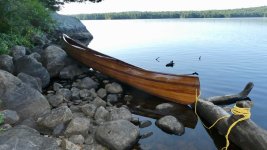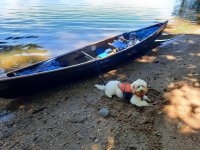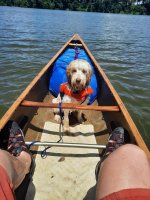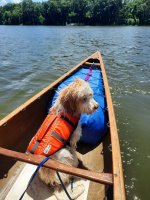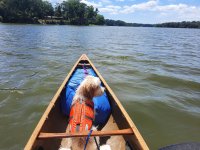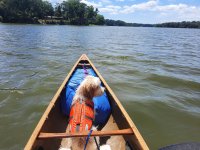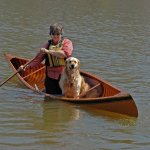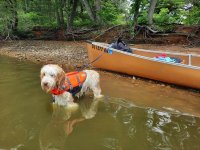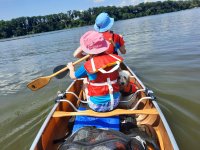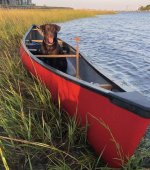- Joined
- Aug 29, 2020
- Messages
- 197
- Reaction score
- 122
This thread follows up on the picture of Cookie that I posted recently in Photo of the Day. Here is another photo:
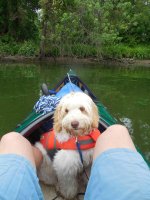
Cookie is our 5 month old medium Labradoodle. I have given her quite a bit of hull time in the last several weeks. She has quickly learned to stay still and not bark at things commonly encountered in a canoe, but, of course, she will need continuing reinforcement. The Canak is perfect to keep her close to me and somewhat confined, but she is rapidly outgrowing it.
She has gotten comfortable enough to go to sleep at my feet when we are in open water where there are no sights or sounds of interest to her:
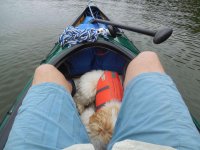
Mike asked if there is any chance she would fit in the front hatch when fully grown, or would that put the Canak bow heavy? She would fit in the front hatch for quite a while yet. It would be bow heavy, but I could compensate with the sliding bucket seat and cargo in the back hatch.
The bigger concern is that she would be mostly out of reach in the front hatch. She needs to be close to get rewards like treats and ear scratches for good behavior. Also, we went swimming (not from a capsize, just for fun) for the first time last week. The Lab in her loved it, and she might decide to go overboard on her own accord, so I want her close to hopefully restrain her.
The family is headed up to the Adirondacks at the end of August. We will be in a Spirit II. I want her fully trained by then to handle a 17’ tandem.
So, this week, we graduate to the 15' Rock Star. She needs to get comfortable with the full, open gunwales.
Any tips on training a puppy in a canoe would be most appreciated. We have not even begun working on getting in and out on command, and only on command.

Cookie is our 5 month old medium Labradoodle. I have given her quite a bit of hull time in the last several weeks. She has quickly learned to stay still and not bark at things commonly encountered in a canoe, but, of course, she will need continuing reinforcement. The Canak is perfect to keep her close to me and somewhat confined, but she is rapidly outgrowing it.
She has gotten comfortable enough to go to sleep at my feet when we are in open water where there are no sights or sounds of interest to her:

Mike asked if there is any chance she would fit in the front hatch when fully grown, or would that put the Canak bow heavy? She would fit in the front hatch for quite a while yet. It would be bow heavy, but I could compensate with the sliding bucket seat and cargo in the back hatch.
The bigger concern is that she would be mostly out of reach in the front hatch. She needs to be close to get rewards like treats and ear scratches for good behavior. Also, we went swimming (not from a capsize, just for fun) for the first time last week. The Lab in her loved it, and she might decide to go overboard on her own accord, so I want her close to hopefully restrain her.
The family is headed up to the Adirondacks at the end of August. We will be in a Spirit II. I want her fully trained by then to handle a 17’ tandem.
So, this week, we graduate to the 15' Rock Star. She needs to get comfortable with the full, open gunwales.
Any tips on training a puppy in a canoe would be most appreciated. We have not even begun working on getting in and out on command, and only on command.

